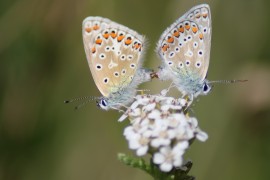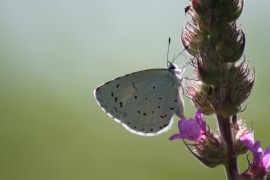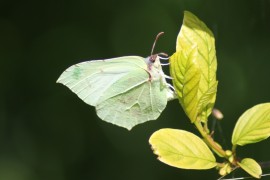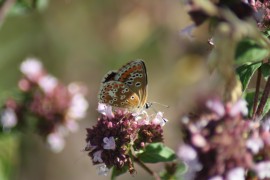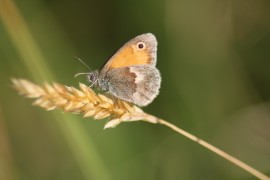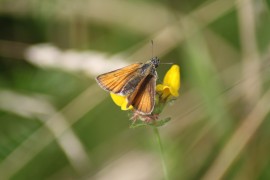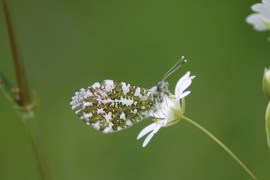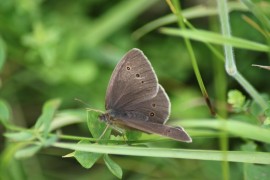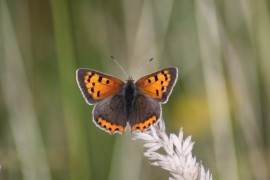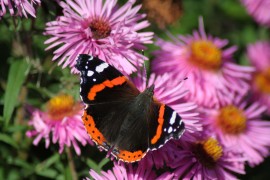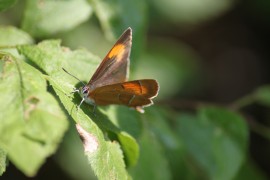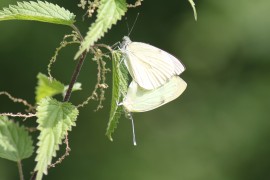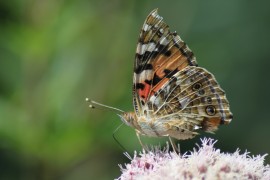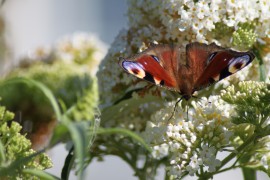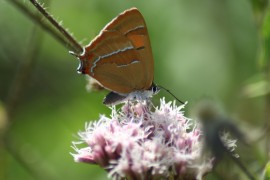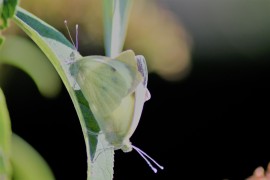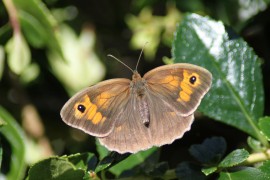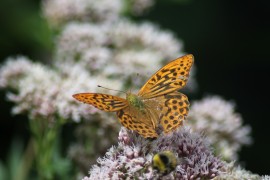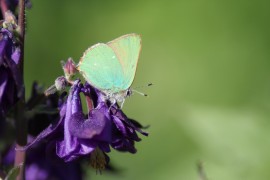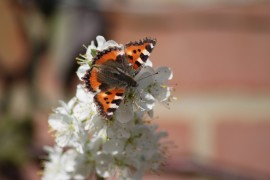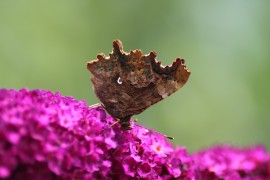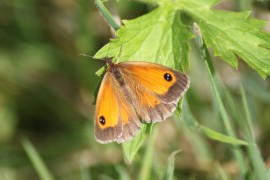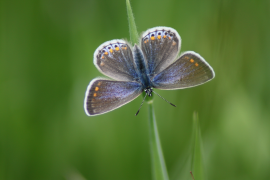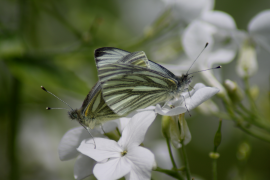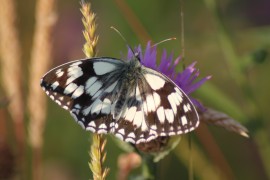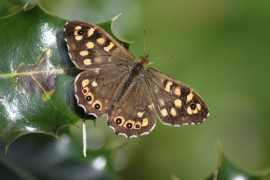Wildlife gardening - Breeding butterflies and other wildlife
By Martin Kalaher
Enticing lots of butterflies into our gardens shouldn't prove too difficult. If we provide plenty of nectar, preferably by planting British Native flowers, then good things should follow. But once they are in the garden how can we persuade them to stay and breed? Of the thirty-two butterfly species so far recorded in the garden some twenty-three species have either bred or at least attempted to do so. In this fourth and final article on wildlife gardening I will explore the ways we might encourage breeding by providing the necessary larval food plants. Before putting pen to paper I thought it would be prudent to do a little background research and so out came 'The Butterflies of Britain & Ireland by Thomas and Lewington'. I made a list of all the garden butterflies so far recorded, added 2-3 more that with luck might come my way and then wrote down all the known larval food plants. It proved to be a very useful exercise and encouraged me to have a re-think about my attitude towards coarse grasses. More about that later.
Since wildlife gardening is in the title and butterflies are not the only living creatures that visit the garden I thought I would finish things off with a brief mention of other residents or visitors.
Larval food plants
A mixture of native grasses
In the past 5-6 years, we have had a good variety of breeding butterflies in the back garden at Cherry House. As outlined in the first three articles, many areas of the garden are contributing to the whole, with the wildflower meadow, herbaceous borders, garden pond, deciduous hedgerows and 'background foliage' all playing their part. That's a broad-brush statement but getting down to the specifics, what plants do we need if we wish visiting butterflies to stay and breed? Well, nine of the twenty-three species are attracted by various types of grass, albeit grass that must be left un-cut for most of the summer. If we consider the three Meadow Skippers: Small Skipper is a specialist of Yorkshire-fog, Large Skipper is largely restricted to Cock's-foot with Essex Skipper also preferring the stems of Cock's-foot or Creeping Soft-grass. Speckled Wood and Ringlet mostly lay their eggs on False Brome and Cock's-foot (with Speckled Wood also using Yorkshire-fog), whilst Meadow Brown, Gatekeeper, Marbled White and Small Heath lean towards the medium and fine bladed grasses, including a wide variety of bents, fescues and meadow-grasses.
By my reckoning, we probably need about a dozen grass species with some sort of balance between coarse, medium and fine grasses. This seems to be getting a bit complicated, or maybe not? If you check any of the specialist nursery websites I think you will find that their various wildflower/grass mixtures do not generally contain any coarse grasses. I would imagine the rationale behind this is to encourage the perennial wildflowers to become well-established without too much early competition from dominant grasses. That makes sense to me. I suspect that for most gardens we don't need to scatter 'coarse' grass seeds as the wind will do the job for us. In the early years of the meadow there is plenty of receptive bare soil and unless one lives a very long way from open countryside, wind-blown seeds are likely to find their own way in. That's what happened in my garden.
In 2016 there were small breeding colonies of all three Meadow Skippers in the garden, so it follows that their 'requirements' must have been met. It was noticeable that Essex Skipper favoured the shorter vegetation where I clip back the grass to encourage Kidney Vetch and Horseshoe Vetch, and I suspect that if this small area of the meadow were to be fully colonised by some of the coarser grasses then Essex Skipper might disappear. Well it might anyway, given the somewhat fickle nature of this species.
Meadow Brown, Gatekeeper and Marbled White all bred in 2016 but I suspect Small Heath didn't, although it has in the past. My 'tiny' wildflower meadow plays a very small part in the complex of grass meadows that surround our garden and with these meadows evolving (in ways which I won't go into in this article) we may well lose Small Heath as a breeding species. We shall see.
Getting the right balance in the wildflower meadow presents us with something of a conundrum for we want the wildflowers (because they look good and provide nectar) but we also need a fair sprinkling of coarse grasses otherwise many butterflies, especially the Skippers, will fail to breed. However, the problem with coarse grasses is that they are dominant grasses, they are inclined to take-over, and then some of the interesting wildflowers and eventually many of the finer grasses are likely to be dwarfed and quite possibly disappear altogether. I guess that is why many meadow enthusiasts like the semi-parasitic Yellow Rattle, as this may help to establish a reasonable balance between the grass species? As previously stated I do have some concerns about Yellow Rattle. Where I have observed this species in my local countryside, I notice that it can become a little too dominant and it too tends to 'take over'. As and when it becomes established in the part of meadow I have designated the 'Orchid Bed' I shall report back my findings (and who knows, maybe retract my reservations!).
This conundrum is one of the reasons why I am likely to be 'messing about' with the garden meadow for years to come! I have given up the idea of replicating an ancient hay meadow and accept that my garden wildflower meadow is entirely artificial. If by regular intervention and manipulation I can continue to attract a nice variety of butterflies and bees, then that's fine by me. I fully accept that others may view things differently.
Other meadow plants
The remaining five species that have bred or attempted to breed in the meadow are Common Blue, Small Blue, Brown Argus, Small Copper and Green Hairstreak. The numbers of Common Blue vary considerably with a second-brood, record count of 25 in 2015 only for the numbers to plummet to a maximum daily count of just 7 in 2016. They lay their eggs mostly on Bird's-foot Trefoil but I also have Greater Bird's-foot Trefoil should they so choose, as well as a variety of other leguminous species that will readily colonise any bare soil that's on offer. A female Small Blue has only graced the garden on one occasion but since I disturbed it on Kidney Vetch I rather suspect it must have laid an egg or two. Kidney Vetch grows very well in the sandy soil found in my garden but the sward height does need to be kept low if it is to re-appear every year. I have several large patches of Kidney Vetch and with a regular Small Blue colony at Kithurst Hill and the occasional butterfly seen at Chantry Hill, I can harbour some hope that they might colonise the garden meadow - but this is probably wishful thinking.
In the past, it was easy enough to record 1-2 Brown Argus every day for 2-3 consecutive weeks but in the past couple of years they have been rather scarce. I do see them but not with any regularity. Ironically, it was one of the first species to colonise the meadow. It seems to prefer thin, sparse vegetation and not the denser vegetation of the more mature meadow? I have a patch of Common Rock-rose in the part of the meadow that I keep clipped back to a shorter sward and there are also many species of wild geranium, wherever the soil has been disturbed.
I recorded 25 different individuals of Small Copper in the garden in 2016, many of them third brood. The garden forms a small part of a modest local Small Copper colony but with plenty of Common Sorrel and Sheep's Sorrel in the meadow and herbaceous borders, I am hopeful this delightful little butterfly will continue to do reasonably well in this locality.
Green hairstreak is not recorded annually, visiting the garden maybe two years out of three. The males hold territory on the shrubbery by the driveway, which is the warmest most protected part in this wind-swept garden. Only once have I firmly identified a female, which was briefly seen flitting from one plant to another and clearly laying eggs on Bird's-foot Trefoil. There is plenty of Dogwood, Buckthorn and Bramble should her Great Grand-daughters decide to come back!
Stocks
As I don't have a vegetable garden and any nasturtiums we plant have never lasted more than a day or two before succumbing to slugs, it remains for the various Stocks to provide sustenance for the White butterflies in the garden. Pink and White Honesty and Dame's Violet grow well on sandy soil and we always have a few Garlic Mustard but I think it is too dry for Cuckooflower and only the odd plant survives.
Shrubbery
A nice variety of shrubs provides balance to any garden with evergreens giving us some colour for the dull winter months. However, there are a few shrubs that may also provide food for hungry caterpillars and the three species that I would not like to be without, are Alder Buckthorn, Blackthorn and Portuguese Laurel. In brief, as I have mentioned them before, Alder Buckthorn needs to be in a sunny, well-sheltered spot and then with luck will attract Brimstone, Blackthorn may entice Brown Hairstreak to visit and Portuguese Laurel provides an alternative to Ivy for second brood Holly Blue.
Common Nettle
Most of us would be horrified at the prospect of having beds of nettles in our gardens and to some degree I concur with that sentiment. Frankly, it is not a very attractive native plant species and mostly we want to get rid of it, not encourage it. However, whether we like it or not the Common Nettle is the larval food plant for Red Admiral, Peacock, Small Tortoiseshell and also Comma, where Hop is unavailable. Since these four species do not share precisely the same requirements it is worth mentioning what these are.
All four species require sun-exposed, sheltered spots although Red Admirals will tolerate semi-shade. The single-brooded Peacock lay its eggs in the spring and chooses large, vigorous plants. The other three require young tender plants and so in the context of a garden bed of nettles it's all about timing. Cut back one patch of nettles in early June to provide tender re-growth in July to satisfy the needs of Small Tortoiseshell and then do the same in late June to a second patch of nettles to ensure that a second-brood of Red Admirals has a fresh flush of nettles in August. As for Comma, forget about the nettles and plant a few Hops! This I intend to do in 2017.
Future possibilities
Comma isn't on my list of 23 breeding species but if I manage to establish a few Hops then that should be rectified.
Somewhat surprisingly, I have yet to record Purple Hairstreak in the garden. I have no mature Oak but with several Oaks in the hedgerows on the eastern border and another 20+ year specimen, which must be 25-30-foot-high it is surely just a matter of time.
Both male and female Dark Green fritillaries have visited the garden in the past couple of years and we do have plenty of garden violets. The Chantry Hill colony of DGFs is expanding rapidly, so you never know!
Other wildlife in the garden
There are always lot of birds in the garden. Abutting open countryside to the south, the location is a good one but the provision of a garden pond and lots of dense cover also play their part. Throughout the day there is a constant stream of birds visiting the pond to drink and bathe. Despite the habitual presence of many predators (local 'moggies', Magpies and Jays being the principal villains) there are many nesting birds and in early May it is not difficult to hear the calls/songs of about 30 bird species that nest within the general vicinity of the garden (many in the garden, itself).
The earth bank has proved to be very good value with breeding Short-tailed Field Voles, Wood Mice, Bank Voles, Common Shrews, Slow Worms and Grass snakes visiting occasionally. I suspect one or more Foxes visit the garden most nights and Badgers are regular visitors, especially in late summer. We also have Hedgehogs, Moles, Rabbits and of course the ubiquitous Grey Squirrels. One-off sightings include five Roe Deer (eating recently-planted Meadowsweet!), an Adder (in the middle of the lawn; I thought it was a stick and almost picked it up!) and a Stoat (which for a few seconds I thought was a Grey Squirrel and then it wasn't). At dusk, in high summer we have two species of bats and lots of them and no doubt we also have many species of moths but I have yet to set a moth trap (that's another way of saying I know nothing about moths!). The garden forms a significant part of a local colony of Glow Worms with double figures in 2016 (the whole colony 50+).
A brief summary
In summary, if we want a good variety of breeding butterflies we need a wildflower meadow with different swards (to accommodate a mixture of coarse, medium and fine grasses), a variety of trees and shrubs, a good supply of Stocks, some patches of nettles and a few hops. Sorted!
Gardening is above all else a practical hobby, helping us to keep fit and encouraging us to be outdoors, enjoying what is around us. If we enjoy the countryside with all its wild creatures, why not consider bringing some of the wildlife closer? I began this series of articles with the herbaceous border as more-or-less every garden has a flower border, so why not convert one of them into a flower bed but one that only contains native species? Not every garden can sensibly accommodate a wildflower meadow but for those who decide to have one there is the prospect of having a dozen British butterfly species breeding there! As for the trees and shrubs we plant in the garden, with a bit of forethought they could be species that help to sustain our native wildlife.
It has been an interesting journey. In truth, few of the decisions made over the past 23 years were given any forethought. There was no master plan. It seemed like a good idea to plant some deciduous hedgerows, so that is what we did. Let's have a garden pond and so we dug a big hole. Looking back, the decision to create a wildflower meadow in 2005 was probably the tipping point together with the introduction of Marjoram and Betony to the meadow in 2015. Now, 23 years on there is plenty of forethought to all my decision-making. What can I do to encourage butterflies, bees and other insects into the garden? With a good variety of native plants and insects the rest of our native wildlife will follow, including many species of birds. My three principal hobbies satisfied; wildlife gardening, birdwatching, recording and photographing butterflies. What more could I ask for?
For those 'hardy folk' who have waded through all four articles I hope you have enjoyed the journey. I know I have.
Acknowledgements
I would like to congratulate Sussex BC for its general ethos of encouragement. It is all too easy to be elitist but that is not how the organisation is run. Well done to all those who contribute towards this inclusive culture. It is working well
Martin and Mary Kalaher
February 2017
Read part one: Wildlife Gardening - the Herbaceous border.
Read part two: Wildlife Gardening - the Wildflower meadow.
Read part three: Wildlife gardening - the 'background foliage'.
If you have any questions you would like to ask Martin please email web@sussex-butterflies.org.uk.



